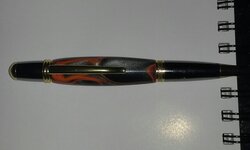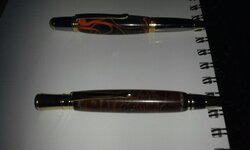These days I generally prep my blank before finishing by sanding up to 1000 grit dry. I do the finer grits at the lowest speed my lathe can spin at, but when sanding an acrylic or stone blank, I do start using water earlier, at around 400 grit and up, but I still go to 1000 grit.
At that point, I thoroughly clean my blank with 90% isopropyl alcohol or acetone, and then apply my CA finish, if it's required for my item. I've found that acrylic doesn't need it, unless it has pits or voids that need filling. Some types of stone don't like CA and can just be polished up and left bare. Some people prefer their antler left bare as well... But generally with wood, I apply Minwax Stain and Seal (natural wood color ... it's a light amber), followed by the first of several coats of CA.
Depending on the item, I generally put between 6 and 15 coats of CA on the item .... small items like a small turned box for my own desk got the 6 coats ... items that will see keys and a pocket, like a keychain, get 15 ... my pens usually get 9 - 12. I DO NOT USE ANY ACCELERATOR. I just wait the 15 - 20 seconds it takes each coat to dry ... usually by applying a coat and sitting down at my nearby computer to watch more anime or whatever TV show I'm watching (currently, SHIELD season 4)... then get up to apply another coat. I generally also end up letting it cure overnight before I take it off the lathe and put the pen together, but before that point, I do my finish sanding and polishing on the lathe.
I'll start with 1000 grit and wet sand all the way through to 12,000 grit micro-mesh. I get my micromesh pads from Hobby Lobby, they typically last me 20 - 30 pens per set.
Once I feel that my blank is as good as it's going to get with sanding, I dry the blank off and then hit it with 1 or 2 doses of Meguair's Plast-X, which is an automotive polishing compound, with the lathe spinning at MAX SPEED. I hear that the grit in this stuff is made to break down into finer and finer stuff as it works, going from about 10,000 grit up to over 30,000 grit. I clean all the Plast-X off with a dry part of the paper towel I applied it with, and then grab a fresh one for the Turtle Wax Hard Surface application. I apply, again with the lathe spinning at MAX SPEED, and give it a nice clear glossy coat. I again make sure there is no excess left over anywhere near the blank, and then turn the lathe off to admire the gleaming gem staring back at me... even common woods are catching eyes, when they look this good!


